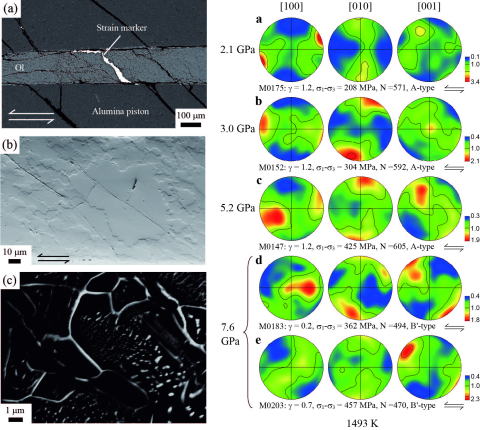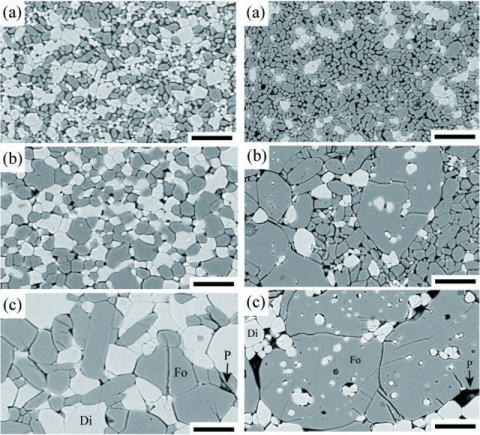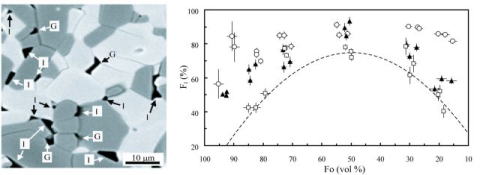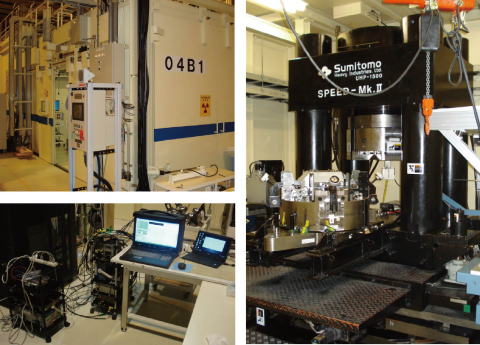![]()
►Rheological properties (e.g., flow behaviors and elastic properties) of minerals and rocks

Left:
Shear deformation of a single-crystal of orthopyroxene (opx) and olivine
polycrystalline (ol). See [8] for details.
Right: Creep strength of
orthopyroxene and olivine under lithospheric conditions. See [8] for details.

Left:
(a, b) Microstructures of deformed olivine aggregates (in simple shear style)
and (c) a typical dislocation microstructure.
Right: Crystallographic
preferred orientation of anhydrous olivine at high pressures (2.1-7.6 GPa) and
1493 K. See [9] for details.
►Grain growth of minerals

Left:
Grain growth of forsterite (50 vol.%) + diopside (50 vol.%) wehrlite under water-saturated
conditions (1.2 GPa and 1473 K).
Right: Grain growth of
forsterite (80 vol.%) + diopside (20 vol.%) wehrlite under water-saturated
conditions (1.2 GPa and 1473 K). See [4] for details.
►Diffusion of elements in fluid-bearing

Left:
Aqueous fluid distribution in wehrlite (i.e., forsterite-clinopyroxene
bimineralic rock) at 1.2 GPa and 1473 K. G: pore fluids surrounded by a single
mineral phase; I: pore fluids surrounded by two different mineral phases.
Right: Time-dependency of pore fluid distribution
in wehrlites with various forsterite/clinopyroxene ratios. Square: 1.5 h;
triangle: 58 h; circle: 160-163 h. See [1] for details.
►Developments of experimental techniques

(a,b) Chemical etching techniques of bi- and poly-mineralic rocks. (c,d) A Griggs-type apparatus and a design of cell assembly (CsCl-type). (e,f) An experimental setup for deformation experiments using a D-DIA apparatus. See [2], [6], [8] for details.
►Acoustic emission monitoring at high pressures

Left: SPring-8 BL04B1 beamline and the AE monitoring system
Right: A deformation-DIA apparatus installed at BL04B1

Upper: The AE monitoring system (collaborated with Dr. X. Lei)
Lower: Example of AE waveforms monitored with 6 recievers.
►TEM observations

a-c) Dislocations and stacking faults in a deformed ringwoodite sample.
d) Ultrafine-grained olivine forming a gouge layer in a deformed/fractured
dunite sample.
e) an amorphos phase (upper part) associated with a olivine grain (lower
part) in a gouge layer in a deformed/fractured dunite sample.
![]()
►Deformation experiments under the conditions of the Earth’s mantle using
a deformation-DIA apparatus combined with MA 6-6 system (and a Griggs-type
apparatus).
►”In-situ” deformation experiments and AE monitoring at a synchrotron facility.
►Grain growth experiments, diffusion experiments, and hot-press experiments
using a Kaway-type multianvil apparatus (a piston-cylinder apparatus).
►Analysis of crystallographic preferred orientation of minerals using the electron backscattered diffraction (EBSD) patterns.
►Observations of microstructures of rocks and dislocations in minerals
and chemical analysis of minerals by using a SEM/FE-SEM and a EPMA.
►Observations of nanometer-scale structures using a ATEM.
►Water content analysis by using a FT-IR.
►Preparation of starting materials using the Sol-Gel technique